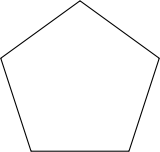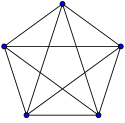Great complex icosidodecahedron
| Great complex icosidodecahedron | |
|---|---|
 | |
| Type | Uniform star polyhedron |
| Elements | F = 32, E = 60 (30x2) V = 12 (χ = -16) |
| Faces by sides | 20{3}+12{5/2} |
| Wythoff symbol | 5 | 3 5/3 |
| Symmetry group | Ih, [5,3], *532 |
| Index references | U-, C-, W- |
| Dual polyhedron | Great complex icosidodecacron |
| Vertex figure |  (3.5/3)5 (3.5/2)5/3 |
| Bowers acronym | Gacid |
In geometry, the great complex icosidodecahedron is a degenerate uniform star polyhedron. It has 12 vertices, and 60 (doubled) edges, and 32 faces, 12 pentagrams and 20 triangles. All edges are doubled (making it degenerate), sharing 4 faces, but are considered as two overlapping edges as topological polyhedron.
It can be constructed from a number of different vertex figures.
As a compound
The great complex icosidodecahedron can be considered a compound of the small stellated dodecahedron, {5/2,5}, and great icosahedron, {3,5/2}, sharing the same vertices and edges, while the second is hidden, being completely contained inside the first.
Its two-dimensional analogue would be the compound of a regular pentagon, {5}, and regular pentagram, {5/2}.
|
See also
- Small complex icosidodecahedron
- Small complex rhombicosidodecahedron
- Complex rhombidodecadodecahedron
- Great complex rhombicosidodecahedron
References
- Coxeter, Harold Scott MacDonald; Longuet-Higgins, M. S.; Miller, J. C. P. (1954), "Uniform polyhedra", Philosophical Transactions of the Royal Society of London. Series A. Mathematical and Physical Sciences, 246: 401–450, doi:10.1098/rsta.1954.0003, ISSN 0080-4614, JSTOR 91532, MR 0062446 (Table 6, degenerate cases)
- Weisstein, Eric W. "Great complex icosidodecahedron". MathWorld.
- Klitzing, Richard. "3D uniform polyhedra o5/3x3o5*a and o3/2x5/2o5*a - gacid".
This article is issued from Wikipedia - version of the 6/9/2016. The text is available under the Creative Commons Attribution/Share Alike but additional terms may apply for the media files.




